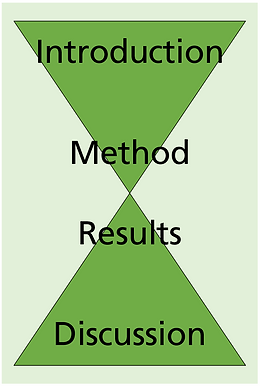
Understanding research papers: A guide for teachers
One of our main goals at The Learning Scientists is to communicate the science of learning. This means, for example, to write blog posts that summarise research papers in a way that is more accessible and that highlight the practical implications of research.
By Carolina Kuepper-Tetzel
Many papers are inaccessible in two ways: First, they may be behind a paywall and schools usually don’t have subscriptions to academic journals, which means that teachers would have to pay to access individual papers. Second, if teachers do happen to get access to research papers, they may find them difficult to understand. The reason for that is that research papers are written for an audience of other academics who are experts in the field and have the background knowledge. However, teachers may benefit from reading research papers in order to get a first-hand account of why and how research is conducted, and what can be concluded from research findings. In this article, I will give an overview of the overall structure of research papers and go into detail as to what teachers may want to focus on within each section of a research paper.
Note: The structure outlined here will apply to most papers published in psychology. However, you may occasionally encounter exceptions here and there to this structure.
Structure of research papers

The overall structure of a research paper will usually follow an hourglass shape. That means that a research paper will start broad by embedding the study into the overall context and state the general issue it addresses. As the Introduction progresses, the scope will become more and more specific. The Introduction ends on a very concrete and narrow note that clearly states the predictions and hypotheses that are being tested by the study. The Introduction is followed by the Method section. Here, the researcher will stay on a concrete and narrow level as they describe how the study was conducted, what materials were used, and who the participants were. Following on from the Method section, the findings of the study are presented in the Results section. Thus, the Results section is still concrete and specific. Last, but not least, the findings are discussed in the Discussion section. Here, the researcher will start narrow by providing a summary of the findings of their study, but then will broaden the discussion by bringing in other literature, limitations, and, finally, drawing more general conclusions. Consequently, the research paper becomes broader as the Discussion progresses. This hourglass structure, i.e., broad-to-narrow/narrow-to-broad, is reflected in most research papers that you will come across.
Introduction section
The aim of the Introduction is to provide the rationale for conducting the study. It answers the ‘Why?’ question: Why is it worth investigating that specific topic? Why should we care about it? The Introduction provides an evidence-based justification for the study. Here the researcher will use different research papers and theories to build a strong argument for the research question and the hypothesis. As you read it, you should be able to guess what the researcher is going to predict at the end of the Introduction. The reason for this is that the researcher will systematically highlight previous findings and point to potential gaps in the literature, anomalies in previous research, or the need to test assumptions of a theory.
Teacher focus: When reading the Introduction, decide how relevant the topic is for your teaching practice. Does the research paper address issues that are directly relevant for you? Have you raised the research question before as part of your teaching? Can the research paper help you solve a problem in your teaching?
Method section
The Method section in a research paper will give a concrete description of how the study was carried out. It answers the ‘How?’ question by providing a description of the participants that took part in the study, the materials that were used, and the procedure of the study. The procedure specifically provides a step-by-step description of what participants had to do in the study. To put it in academic terms, the Method section outlines how the hypothesis was operationalised. This is just a fancy way to say how the hypothesis was tested.
Teacher focus: As a teacher you may want to pay attention to the material used and how the study was set up. Ask yourself if the study methods are a good representation of materials and set-ups you use in your classroom. This will help you to put the study into context. Note: No study will ever perfectly match your classroom, but there may be important elements that can be mapped onto your teaching practice.
Results section
In the Results section the findings of the study are reported. Here, the researcher will present the data in the form of figures and/or tables and provide a report of the statistics. Essentially, the Results section answers the ‘What?’ question by presenting what the outcome of the study was. After presenting statistical tests, researchers will usually provide short statements detailing what the outcome of the tests mean. Long-winded interpretations of the results are usually not provided here, but rather discussed in the next section – the Discussion section.
Teacher focus: Admittedly, this section is the most challenging to go through as teachers may not necessarily have the background knowledge to wrap their heads around the statistical tests. When I started to read research papers, I remember this being challenging for me, too. As a starting point, I would begin by looking at the figures and tables and try to map what you see in them with points reported in the text. Also, you may want to look out for the size of effects. Thus, if you, for example, have a study that tested two different conditions against each other – say re-reading versus retrieval practice – you want to check how big the differences are between the two groups and how spread out the data are in each of them. The reason for this is that you are probably most interested in meaningful results that are likely to make a difference in your classroom, compared to tiny effects.
Discussion and conclusion section
Finally, the Discussion section is the place where the study findings are embedded within the wider literature. This section usually starts with a summary of the results and then relates these findings to the hypotheses, previous research and theory. As such, the Discussion section answers the ‘So What?’ question. Here, the researcher will provide a critical evaluation and interpretation of the findings. They will also point out any limitations and how they can be addressed in future studies. Depending on the topic and scope of the paper, you will find a few practical implications stated here. The Discussion section will end with a general conclusion of the research conducted.
Teacher focus: Teachers may want to focus specifically on the practical implications stated here (or come up with their own practical implications if none are provided). In addition, reading through the limitations raised is a good way to decide if the research findings are applicable to your specific classroom context. Finally, teachers should pay attention to the theories proposed to explain the findings. These usually give important insight into the (cognitive) processes that may be responsible for the effects and provide an explanation why the findings occurred. When thinking about using the findings to inform teaching practice, teachers may want to think about how they could maximise the proposed (cognitive) processes in their pupils – using teaching materials in their classrooms.
Tips for starting your reading journey
-
When deciding which papers to read, think about your current teaching practice and any issues you want to tackle in your classroom. Also, look for existing overlap between your teaching practice and research papers. For example, if you are already using retrieval practice in your teaching, you may be interested in different quiz formats and could look specifically for papers on this.
-
Try to read several papers on the same topic to get a fuller picture of the research field.
-
If you don’t know where to start, review papers are a good way in. They offer an overview of a topic by reviewing different papers. The structure of review papers is not like the one discussed here (i.e., they do not come with the different sections highlighted here), but from review papers you may learn about specific research papers that you can then look up.
-
Get together with colleagues to explore the reading journey together. Raise and answer each other’s questions about the research paper. Reflect on your teaching practice and map your experience to the points raised in the research paper.
Accessing research papers
As stated in the beginning, it can be tricky to get one’s hands on research papers because many journals require either a subscription or payment to read the papers. However, there is an increasing trend in psychological science of offering open access to journals and papers. Just to name a few examples of journals that feature some open access papers: Psychology Learning and Teaching, Psychological Science in the Public Interest, PLOS One, International Journal of Inclusive Education, and Frontiers in Psychology. In addition, there are platforms where researchers upload paper manuscripts that they are about to submit to journals, so that others can read the papers before they are printed. Examples of such preprint platforms are: EdArXiv or PsyArXiv.
This article appeared in the Dec 2021 edition of Nomanis.
This article originally appeared on The Learning Scientists blog.
Dr Carolina Kuepper-Tetzel [@pimpmymemory, @AceThatTest, @TILEnetwork] is Senior Lecturer
in Psychology at the University of Glasgow, an expert in applying findings from cognitive science to
education, and an enthusiastic science communicator. She obtained her PhD in Cognitive Psychology from the University of Mannheim and pursued postdoctoral positions at York University in Toronto and the Center for Integrative Research on Cognition, Learning, and Education (CIRCLE) at Washington University in St Louis. She was Lecturer in Psychology at the University of Dundee for four years before joining the University of Glasgow in January 2020. Her expertise focuses on learning and memory phenomena that allow implementation in educational settings to offer teachers and students a wide range of strategies that promote long-term retention.